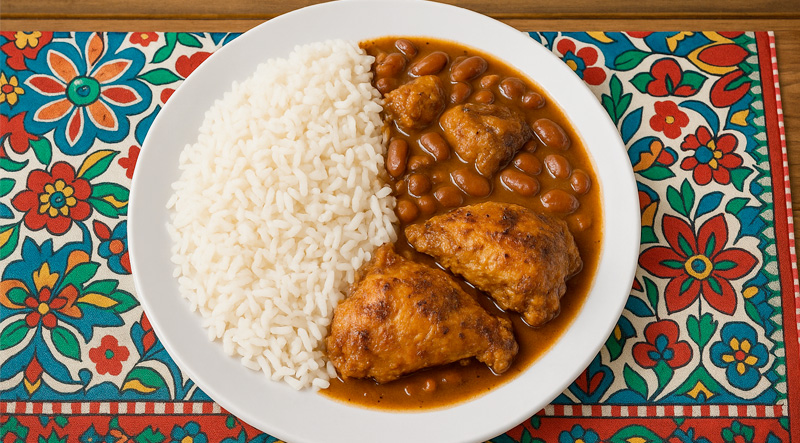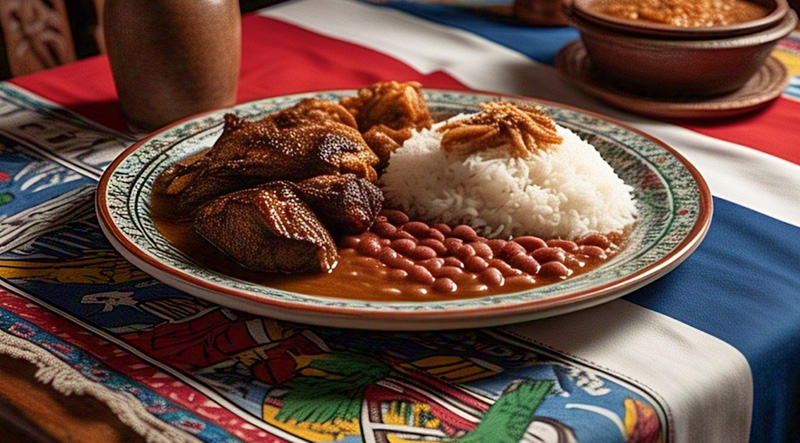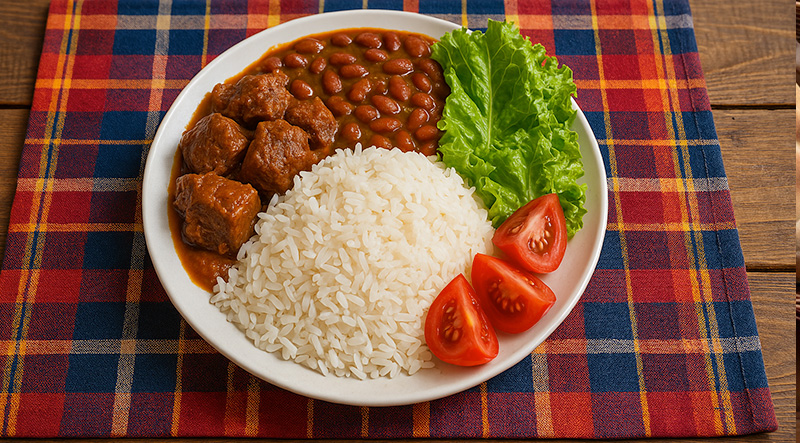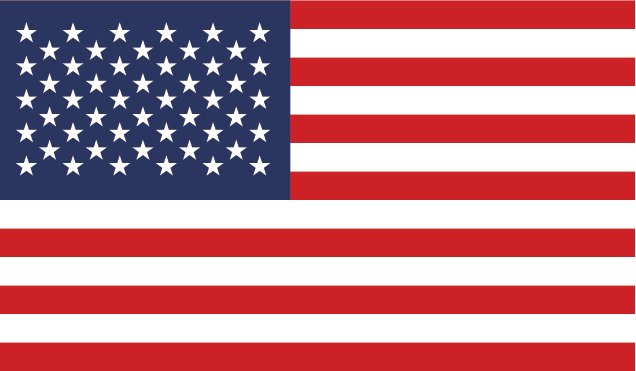Meet La Bandera Dominicana, the beloved national dish of the Dominican Republic that proudly waves the flag of flavor on every plate! Named after the country's tricolor flag, this hearty and colorful meal features tender stewed meat, creamy red beans, and fluffy white rice—often accompanied by crispy fried plantains and a fresh avocado slice. It’s more than just food; it’s a daily celebration of Dominican heritage, served with warmth, tradition, and a whole lot of sabor. Read More...
La Bandera Dominicana – The Tasty Story Behind the Dominican Republic’s National Dish:
When you hear a Dominican say, “Vamos a comer la bandera,” they’re not talking about fabric—they’re talking about the soul of Dominican cuisine. La Bandera Dominicana, or “The Dominican Flag,” is a cherished national dish that represents much more than just food. This beloved trio of white rice, red beans, and meat is a flavorful tribute to the country’s history, resilience, and identity.
Roots in Colonial Fusion:
The origins of La Bandera Dominicana trace back to the colonial era, when Spanish colonizers introduced rice, livestock, and new cooking techniques to the island. African influences—especially stews and the use of legumes—merged with native Taíno traditions, creating a cuisine built on bold seasonings and hearty ingredients. This blend of cultures laid the foundation for the classic Dominican plate: rice, beans, and protein, usually chicken, beef, or pork.
A Flag on a Plate:
After the Dominican Republic gained independence from Haiti in 1844, the new nation began to embrace symbols that reflected its unique identity. Around this time, the daily staple of rice, beans, and meat earned the nickname “La Bandera” because it symbolically mirrored the colors of the Dominican flag—white (rice), red (beans), and blue (meat, representing liberty and strength). Though the meat isn’t blue in color, its presence completes the symbolic trio and adds heartiness to the meal.
The Midday Ritual:
Traditionally, La Bandera Dominicana is the star of lunch—the main meal of the day. Whether enjoyed at home, in a small neighborhood eatery, or packed for work, it has been a constant presence on Dominican tables for generations. Families gather around the table in the early afternoon to eat this nourishing dish, often accompanied by sides like fried plantains (tostones), avocado, or a light salad. It’s more than a meal; it’s a daily ritual that brings people together.
A Symbol at Home and Abroad:
In the 20th century, La Bandera grew in prominence as a culinary symbol of Dominican pride. It appeared in cookbooks, was celebrated during national holidays, and became a key part of family traditions. As Dominicans migrated abroad—especially to the United States and Spain—they brought La Bandera with them. Today, it’s a staple in Dominican restaurants around the world, connecting generations to their roots with each savory bite.
A Dish of National Pride:
Although not legally declared the national dish, La Bandera Dominicana holds that status in the hearts of the people. It’s a humble yet powerful reflection of the country’s history, culture, and everyday life. While other dishes like sancocho or mangú are also popular, none carry the symbolic weight and daily presence that La Bandera does.
More Than Just a Meal:
La Bandera Dominicana is a flavorful metaphor for the Dominican experience—a dish that speaks of heritage, resilience, and unity. It’s a meal born of necessity and shaped by generations, but still savored today with the same passion. Whether served in a simple home kitchen or a bustling city restaurant, it remains a delicious reminder of where the Dominican Republic has come from—and the pride with which its people carry their culture forward.
Cook the White Rice:
Prepare the Stewed Beans:

Cook the Meat (Pollo or Res Guisado):

Optional Sides:

To Serve:
On a plate, arrange a generous portion of white rice, a ladle of stewed beans, and a portion of stewed meat. Add your preferred side dishes, and enjoy a taste of the Dominican Republic with every bite!
The total preparation and cooking time for La Bandera Dominicana is approximately 1 hour and 30 minutes. This includes about 20–30 minutes for ingredient preparation such as cleaning and marinating the meat, chopping vegetables, and rinsing rice and beans. Cooking the rice takes around 20 minutes, while the stewed beans and meat require 30 to 60 minutes depending on whether you use chicken (quicker) or beef (longer simmering). Optional sides like fried plantains or salad add an extra 10–15 minutes. With efficient multitasking in the kitchen, the full meal can comfortably be prepared and ready to serve in under an hour and a half.
A single serving of La Bandera Dominicana, based on the recipe provided, contains approximately 650 to 750 calories. This estimate includes one cup of cooked white rice (about 200 calories), half a cup of stewed red beans (around 150 calories), and roughly 4–5 ounces of stewed chicken or beef (approximately 250–300 calories depending on the meat and fat content). If served with a side of fried plantains, add another 100–150 calories. Avocado or salad sides contribute minimally, with avocado adding healthy fats (about 80 calories for a few slices) and cabbage salad less than 50 calories. The dish is hearty, balanced, and rich in protein, fiber, and flavor.







